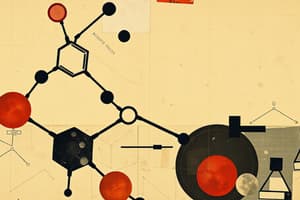Podcast
Questions and Answers
What characteristic of alkenes makes them susceptible to electrophilic attack?
What characteristic of alkenes makes them susceptible to electrophilic attack?
- The low electron density in the double bond.
- The presence of single bonds.
- The high electron density in the double bond. (correct)
- The presence of highly electronegative atoms.
What type of reagent is $Br_2$ in the reaction of bromine with alkenes?
What type of reagent is $Br_2$ in the reaction of bromine with alkenes?
- Reducing agent
- Nucleophile
- Electrophile (correct)
- Radical
What is the functional group transformation when an alkene reacts with bromine?
What is the functional group transformation when an alkene reacts with bromine?
- Alkene to haloalkane
- Alkene to dihalogenoalkane (correct)
- Alcohol to alkene
- Alkane to alcohol
What is the role of the $\pi$ bond electrons in an alkene during bromination?
What is the role of the $\pi$ bond electrons in an alkene during bromination?
What type of intermediate is formed during the electrophilic addition of bromine to an alkene?
What type of intermediate is formed during the electrophilic addition of bromine to an alkene?
What is the primary use of the reaction between bromine and bromine water with an alkene?
What is the primary use of the reaction between bromine and bromine water with an alkene?
What is the first step in the electrophilic addition of HBr to an alkene?
What is the first step in the electrophilic addition of HBr to an alkene?
According to Markovnikov's rule, in the addition of HBr to an asymmetric alkene, which carbon atom does hydrogen preferentially add to?
According to Markovnikov's rule, in the addition of HBr to an asymmetric alkene, which carbon atom does hydrogen preferentially add to?
Why is one product favored over another in the electrophilic addition of HBr to an asymmetrical alkene, according to Markovnikov's rule?
Why is one product favored over another in the electrophilic addition of HBr to an asymmetrical alkene, according to Markovnikov's rule?
In the context of carbocation stability, how do alkyl groups influence the positive charge on the carbocation ion?
In the context of carbocation stability, how do alkyl groups influence the positive charge on the carbocation ion?
How does the inductive effect of alkyl groups contribute to the stability of a carbocation intermediate?
How does the inductive effect of alkyl groups contribute to the stability of a carbocation intermediate?
Which factor primarily determines the major product in the electrophilic addition of HBr to an asymmetric alkene?
Which factor primarily determines the major product in the electrophilic addition of HBr to an asymmetric alkene?
In electrophilic addition reactions, what is the significance of 'inducing a dipole' in a molecule like $Br_2$?
In electrophilic addition reactions, what is the significance of 'inducing a dipole' in a molecule like $Br_2$?
If an alkene reacts with bromine water and forms a bromonium ion intermediate before undergoing nucleophilic attack by water, what is the stereochemistry of the resulting product?
If an alkene reacts with bromine water and forms a bromonium ion intermediate before undergoing nucleophilic attack by water, what is the stereochemistry of the resulting product?
Considering the reaction of HBr with 2-methylpropene, which carbocation intermediate is more stable and why?
Considering the reaction of HBr with 2-methylpropene, which carbocation intermediate is more stable and why?
Predict the major product of the reaction of 2-methyl-2-butene with HBr.
Predict the major product of the reaction of 2-methyl-2-butene with HBr.
Which of the following alkenes will react fastest with HBr?
Which of the following alkenes will react fastest with HBr?
Consider the electrophilic addition of HBr to 1-methylcyclohexene. Which of the following factors contributes most to the regioselectivity of the reaction?
Consider the electrophilic addition of HBr to 1-methylcyclohexene. Which of the following factors contributes most to the regioselectivity of the reaction?
What is the role of a polar protic solvent in the electrophilic addition of HBr to an alkene?
What is the role of a polar protic solvent in the electrophilic addition of HBr to an alkene?
Which statement regarding electrophilic addition of bromine to alkenes is incorrect?
Which statement regarding electrophilic addition of bromine to alkenes is incorrect?
Flashcards
Electrophile
Electrophile
An electron pair acceptor.
Addition reaction
Addition reaction
A reaction where two molecules react together to produce one molecule.
Reaction of Bromine with Alkenes
Reaction of Bromine with Alkenes
Alkene transforms into a dihalogenoalkane.
Carbocation
Carbocation
Signup and view all the flashcards
Markovnikov's Rule
Markovnikov's Rule
Signup and view all the flashcards
Alkyl Groups
Alkyl Groups
Signup and view all the flashcards
Reaction of Bromine with Alkenes
Reaction of Bromine with Alkenes
Signup and view all the flashcards
Bromine Water Test
Bromine Water Test
Signup and view all the flashcards
Study Notes
- Alkenes have double bonds that contain high electron density areas.
Electrophilic Addition
- Refers to a reaction alkenes undergo
- Attracts electrophiles
Electrophile
- An electron pair acceptor.
- Addition reaction is when two molecules react together to produce one molecule.
Reaction of Bromine with Alkenes
- Functional group changes from alkene to dihalogenoalkane.
- Uses Bromine as a reagent.
- Occurs at room temperature, avoiding UV light.
- Mechanism is electrophilic addition.
- Electrophile, Brδ+ is the type of reagent.
- As the Br₂ molecule gets close to the alkene, the pi bond electrons push away the electron pair in the Br-Br bond.
- A dipole is induced, and Br₂ becomes polar and electrophilic (Brδ+).
- An intermediate with a positive charge on a carbon atom, known as a carbocation, is formed.
- Reaction with Bromine and bromine water tests for unsaturation.
- Alkenes decolourise bromine.
Electrophilic Addition of Bromine Water to an Alkene
- Reactants are Br₂ + H₂O
- Produces HBr
Electrophilic Addition of HBr to an Alkene
Electrophilic Addition of HBr to an Asymmetrical Alkene
- The hydrogen atom can attach to the carbon connected to the R group on the right, or to the carbon connected to the two hydrogens on the left.
- Route 1's carbocation intermediate is stabilized by the alkyl group's inductive effect (R) and is formed faster.
- Route 2's positive charge is not stabilized by inductive effects and is formed more slowly.
- Route 1 is the primary product and route 2 is the minor product.
Markovnikov's Rule
- In asymmetric electrophilic addition, hydrogen attaches to the carbon with the most hydrogen atoms already attached.
- Hydrogen from hydrogen bromide will preferentially attach to the left-hand carbon, following route 1.
- Route 2 remains a possibility, but it is only a small amount of the product (perhaps just a couple of percent).
- Crucial to understand that the stability of the intermediate created in the two potential mechanism routes.
- The intermediate is a carbocation ion in both routes.
- In route 2, the intermediate carbocation ion positive charge is located on a carbon bonded to two hydrogen atoms.
- Does nothing to stabilize the ion.
- The carbocation ion positive charge in route 1 is located on a carbon with an alkyl (R) group attached.
- Alkyl groups function as 'electron pumps,' generating negative charge away from themselves.
- The positive charge on the carbocation ion is stabilized by this induction of negative charge, making the ion more stable.
- A more stable ion forms more easily, and the mechanism for the addition favors this stable ion.
- Route 1 is favored.
Studying That Suits You
Use AI to generate personalized quizzes and flashcards to suit your learning preferences.




